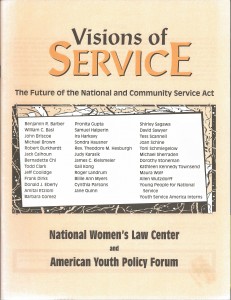 The National and Community Service Act was a beacon, challenging us to help youth understand that how our brothers and sisters are faring is a more important question than whether one owns the newest in Guess? jeans. The Act is a thrilling starting point, but we will unleash the transforming potential of service and involve the greatest numbers unless youth themselves are actively involved in identifying issues of interest and crafting solutions to them, and unless community service is an accepted ethos in communities large and small across the nation. Will the passage of another decade see youth service embedded in the hearts and minds of each generation? Maybe. Maybe not. The redrawing of the National and Community Service Act in 1993 can lay the foundations for a sturdy community service construct for generations to come or leave an ephemeral framework that collapses into the special interest group category.
The National and Community Service Act was a beacon, challenging us to help youth understand that how our brothers and sisters are faring is a more important question than whether one owns the newest in Guess? jeans. The Act is a thrilling starting point, but we will unleash the transforming potential of service and involve the greatest numbers unless youth themselves are actively involved in identifying issues of interest and crafting solutions to them, and unless community service is an accepted ethos in communities large and small across the nation. Will the passage of another decade see youth service embedded in the hearts and minds of each generation? Maybe. Maybe not. The redrawing of the National and Community Service Act in 1993 can lay the foundations for a sturdy community service construct for generations to come or leave an ephemeral framework that collapses into the special interest group category.
We share a common vision that foresees a society in which the issue of voluntary versus mandatory service is no longer relevant-because people not only want to serve but see community service as vital to their own well-being. Teaching community service would not be a duty imposed on overburdened schools but an opportunity for all. In the bright future, people have multiple avenues for service in multiple settings in every community across the land.
If this vision is to become reality, several things must happen. The concept of youth service must become pervasive; it must be seen as empowering; it must be localized; it must encourage personal investment; it must offer a variety of positive incentives. Pervasive: The idea of service to others needs to be a part of the warp and woof of civic life. It should be both an expectation and a resource. It is not enough that we have a tradition of volunteerism. Service cannot be confined to a few specific institutions and “special initiatives.” Moreover, it cannot be seen as applying only to specific groups or kinds of people or to defined areas of work.
Empowering: Every human being wants to be able to control, as much as possible, decisions that affect life. The more empowering youth service programs are-the more that young people have a say in what gets done and how it’s done-the more likely the programs are to succeed.
Localized: Left as a generalized national goal, community service will float in the policy sphere, its conceptual string clutched only in the hands of those who have deep investment in the concept. Localized-made tangible, specific, and owned at the community and even the neighborhood level it gains constantly renewed vitality, high relevance to daily lives, and a growing body of advocates.
Grounded in personal investment: Personal conviction that community service is beneficial especially conviction that grows out of direct experience drives the convinced individual to seek out areas in which community service can help, people who could serve if recruited, and ways to maximize the returns of service to all.
Driven by positive incentives: Our national character tends to be repulsed by government compulsion, absent an overwhelming need for protection against disaster. If we are truly to become a serving culture, if servant leadership is to become the norm, then the servants must be willing. Mandating service is not a permanent solution, though it may be the boost that gets the movement rolling.
We know the importance of these features in community service because they are key components of the successful and growing Youth as Resources (YAR) programs. YAR was piloted in Boston, developed in three Indiana cities and spread to other sites in that state with funding from the Lilly Endowment. It is already expanding to communities across America.
It is clear to us that the pervasiveness, empowerment, personal investment, as well as the local and voluntary nature of YAR have been critical to its astonishing success. Crafters of the 1993 version of the Act must find ways to reflect such principles and to encourage them. Youth Corps efforts are promising, but not every youth is able to serve full time or away from home. College service is commendable, but not everyone goes to college and not everyone can serve if there. School- based service can mean a revolution in learning-but it can also mean additional demands on an already-beleaguered system.
School systems have even begun to shorten their days, giving students more unoccupied time during the day. Meanwhile, communities-their streets, libraries, museums, malls and youth centers-have become de facto latchkey care programs.
YAR is grounded in pervasiveness, empowerment, local service, personal investment, and positive incentives:
Pervasiveness: YAR has attracted young people who range from drop-outs to Scouts, from barely passing to honor roll, from delinquent to model citizen. It has attracted community participation from churches, youth-serving agencies, schools, juvenile detention facilities, businesses, civic groups and more. Because of YAR-related experiences, community organizations ranging from the Hispanic Festival to the United Way have brought young people into active, full membership on their Boards.
Empowerment: YAR is empowerment for youth. Young people pick the issues and decide what to do about them. They develop the project plan and budget and advocate for its approval. If they get the OK, they take charge of carrying it out and the skills and capacities that young people bring are valued.
Erin, whose tangled personal history has placed her in an institution serving delinquent girls, saw how even the simple gift of a recipe could be of value: “At first I felt real bad the people in the shelter didn’t have anything and I did, and then I felt good because I could give them something [food made from her mother’s recipe].”
Local service: YAR is grounded in the local community. Its grant-making board consists of adults and youth from that community.
Organizations that sponsor the young applicants are from that community. Priorities are those of the grant -seeking youth in that community. Beneficiaries are right there in the community. Equally important, YAR is flexible and can be quite inexpensive (project grants of $500 to $1,500 are the norm).
Personal investment: Youth and adults who have been involved in YAR become invested in substantial numbers in the concept of community service. One young man summed up the transformation concisely: “We got into this just to say we were doing it, and then we were going to get out. Now we wouldn’t leave for anything.”
Positive incentives: YAR is voluntary and open to all. Youth are not required to take part. But they are offered the opportunity for enjoyable activities and public acclaim (project kick- offs, youth celebrations, news coverage, and award ceremonies, for example), and more important, they are offered power and authority through the grant making process in which they, not adults, take charge.
Three more elements are important to the success of YAR. First, each youth can use his or her unique gifts: Dancers created an original work on resisting peer pressure; good listeners have mediated disputes; artists have developed murals and brochures; teen mothers developed a play on the realities of teen pregnancy and parenting; Girl Scouts helped care for children at a shelter for battered women.
Second, youth work in contexts in which they feel comfortable, whether a community center, arts institute, school, church, Boys’ and Girls’ Club, or wherever. They work near home, near school, at a local playground, or across town at a shelter. They work with and in a framework they helped to create.
Third, YAR applicants design a project on something they feel is important, that they feel they can fix-or at least help improve. They are challenged to look at the community, identify problems, and figure out solutions. The problems they have dealt with-ranging from homelessness to day care, from drop-out and pregnancy prevention to needs of the elderly-are at the core of today’s social needs. In describing to the YAR Board the need for her Girls, Inc.-sponsored project, eleven-year-old Kamieka explained,
“Just because these people are old doesn’t mean we have to set them aside. We want to show them that we care about them and make friends so they won’t think kids and teenagers are self-centered.” The group’s application was approved.
The community service movement is rich. The enthusiasm built for school-based, college-based, youth corps, and community-based programs is a major resource. But it is one that can be too quickly and tragically squandered.
Unless the concept is woven into the very fabric of the community’s normalizing and mediating institutions, unless the idea is locally owned as well as nationally stimulated, the beneficiaries of the Act will be few, its advocates fewer, and its lifespan regrettably short. We cannot afford in this reauthorization to settle for anything less than a system that makes youth service pervasive, local, empowering, positively driven, and personally invested. We won’t get a second chance.
Jack Calhoun, Executive Director of the National Crime Prevention Council, has served as Massachusetts Commissioner of Youth Services and Chair of the State’s Adolescent Task Force. He was appointed by President Carter to be U.S. Commissioner of the Administration for Children, Youth, and Families. He currently serves on numerous boards, including those of Youth Service America, National Center for Early Adolescence, and the National Assembly.
* Originally published in 1993 in Visions of Service: The Future of the National and Community Service Act, a publication of the National Women’s Law Center and the American Youth Policy Forum.



 Yesbet88 says
Yesbet88 says
February 12, 2020 at 11:11 amBest news from around the world !